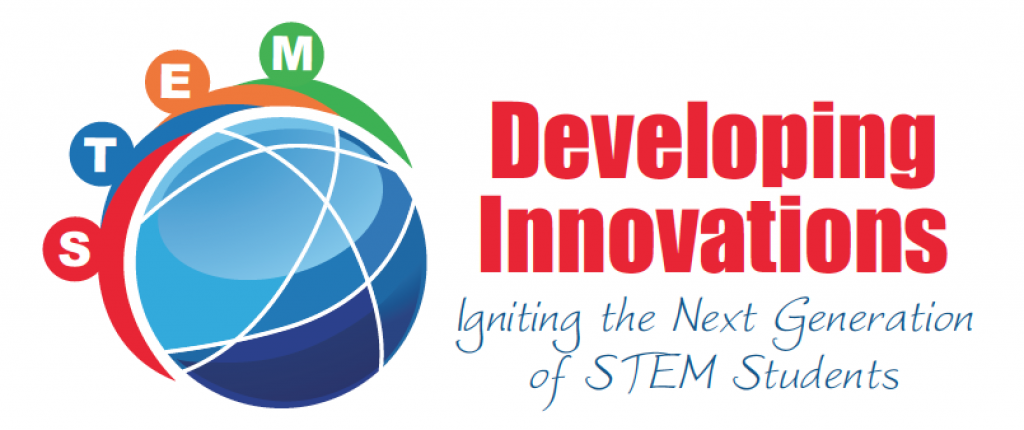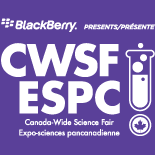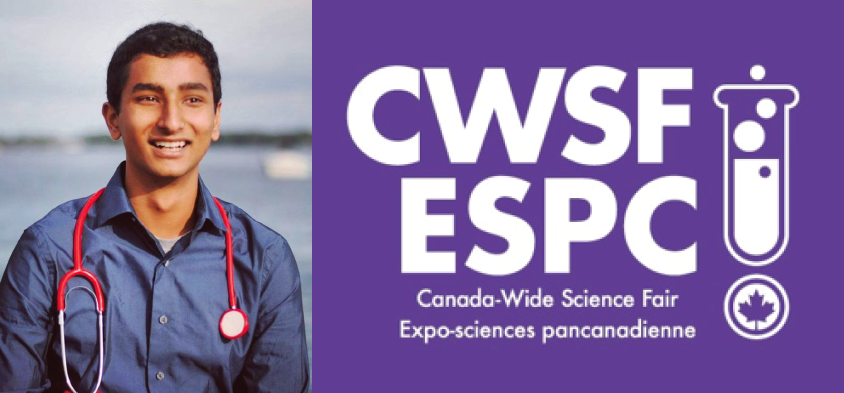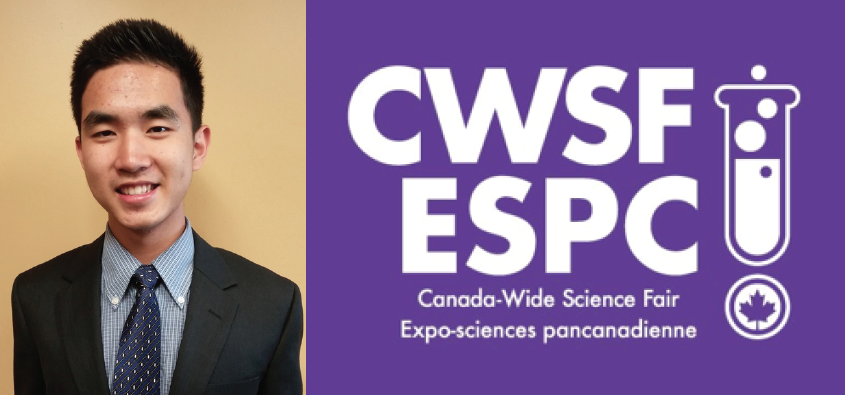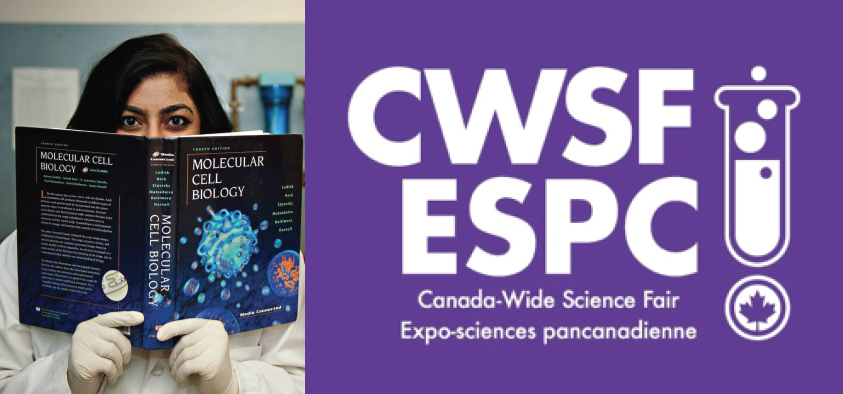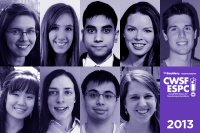Within the National Science Fair Program, the Canada-Wide Science Fair constitutes the national championship round, where finalists from Regional Science Fairs across the country meet and compete.
In bringing Canada’s top young scientists together, the CWSF aims to accomplish two primary goals: to help participants benchmark their scientific and technological achievements against those of peers and to create a positive scientific and social experience for all the young people involved. A secondary goal is to expose other students in the CWSF’s geographic area to peer role models – the best young science and technology minds in the country.
The CWSF takes place in May in a different Canadian city each year. Youth Science Canada – affiliated Regional Science Fairs apply to host the CWSF up to four years in advance.
Next Event: May 9th to 16th, 2015 Fredericton, New Brunswick
https://cwsf.youthscience.ca/
“Pick a flower like Dirac, gaze into the ocean of knowledge like Newton, and make mistakes like Einstein, at end, you’ll be looking at a stellar science fair project.”
Adree Mughda Khondker (CWSF 2014 – Bronze Medalist & Scholarships)
Interested in learning more about Adree Mughda Khondker https://developinginnovations.org/?page_id=332
“Working on a science fair project has taught me important lessons in hard work, patience and perseverance. At the CWSF I had the chance to engage with like-minded individuals who shared my passion for science and the aspiration for excellence.”
Austin Wang (CWSF 2014 – Silver Medalist & Scholarship)
Interested in learning more about other amazing S.T.E.M. students and the latest S.T.E.M. news:
Like us at http://www.facebook.com/developinginnovations.org
Follow us at https://twitter.com/Aidan_Aird
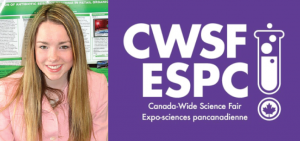
Chloe Devoy
“CWSF has given me so many great opportunities! I’ve met kids from all over Canada that have the same passion for science as I do, learnt about incredible and inspiring projects, I’ve been able to travel, not to mention miss a full week of school! Science fair is always something I look forward to.”
Chloe Devoy (CWSF 2013 – Gold Medalist & Scholarship; 2014 Bronze Medalist & Scholarship)
Interested in learning more about other amazing S.T.E.M. students and the latest S.T.E.M. news:
Like us at http://www.facebook.com/developinginnovations.org
Follow us at https://twitter.com/Aidan_Aird
CWSF Awards
Special Awards
These awards are for outstanding projects that meet specific criteria within a particular aspect of science and often reflect the special interests of the sponsoring foundations, companies and professional associations. All Special Awards are cash prizes: $500 for Junior, $750 for Intermediate and $1,000 for Senior.
Self-nomination is not required for these awards. Interviews for these awards are unscheduled, and students may or may not see a judge for one of these awards.
View Special Awards
Interdisciplinary Awards
Interdisciplinary Awards are open to all projects in the appropriate grade category and include cash awards, trips, summer internships and other prizes for outstanding projects that meet specific criteria established by the sponsor(s).
Self-nomination is a commitment to accept the award as offered. If you plan to nominate your project for a travel or summer experience award, be sure you do so only after careful consideration and with parent/guardian approval.
Please note: Certain Interdisciplinary Awards involve travel and a commitment to be away from home for an extended period of time, to travel to another country and/or to live in unfamiliar surroundings. All travel involves an element of risk. Foreign Affairs Canada provides advice to international travellers through their website.
Interdisciplinary Awards judges spend approximately 10 minutes with each project. Judges expect to hear a brief (5 minute) summary of the project and why it deserves the award, followed by time for questions.
Self-nomination is required; judges will only consider projects that the finalists have nominated for these awards in the online registration system. The list includes all available Interdisciplinary Awards. A project may be nominated for up to three Interdisciplinary awards. Only those awards for which a project is eligible will appear in the Interdisciplinary Awards area of the CWSF online registration system.
View Interdisciplinary Awards
Challenge Awards
Challenge Awards recognize the top project in each of the 7 Canada-Wide Youth Science Challenges in each grade category. The seven Canada-Wide Youth Science Challenges – Discovery, Energy, Environment, Health, Information, Innovation and Resources – focus on issues that are important to Canadian youth, the future of their country and their world. They are meant to inspire students to exercise their curiosity and creativity by answering a question or solving a problem by doing a science project.
At the CWSF, 3 prizes are awarded – junior ($500), intermediate ($750) and senior ($1,000) – for the best project that addresses each challenge.
During registration, finalists identify the challenge best addressed by their project. Interviews for these awards are unscheduled, and students may or may not see a judge for one of these awards.
View Challenge Awards.
Excellence Awards
Excellence Awards (CWSF medals) recognize science and technology excellence. The judging is a relative process, with medals awarded based on the ranking of consensus scores for each project within a grade category. A total of 70 medals is available in each grade category – junior, intermediate, and senior:
- 10 Gold Medals (including $700 cash)
- 20 Silver Medals (including $300 cash)
- 40 Bronze Medals (including $100 cash)
All medals are normally awarded as judged; however, the awarding of a gold medal requires that the following minimum standard be attained:
- The project demonstrates Level 3 or 4 of Scientific Thought (see Judge’s Marking Sheet).
- Analysis and conclusions are appropriate and based on the data;
- The project demonstrates some knowledge of the relevant background and theory; and
- The project contains no glaring or significant errors.
Each judging team is assigned a specific group of projects in the same grade category. Normally, four different judges evaluate each project. Judging is a three-step process:
First, judges read the Project Reports in advance and, on the evening before judging, view the projects without the finalists being present.
On judging day, each of the four judges meets with the finalist(s) for about 20-minutes. Judges expect to spend approximately 10 minutes hearing a presentation about the project, followed by 10 minutes for questions.
After the finalists have left the exhibit area for the day, each judging team meets to discuss each project and assign a consensus score based on the project level and relative merit of each project. After these scores are compiled, representatives of each judging team within a grade category meet to review the ranked scores and determine the Excellence (medal) and Challenge Award recipients. This step involves considerable discussion among the judges and may require additional viewing of projects without the finalists present. Sponsor representatives may work with the category teams at this time to select the recipients of Special Awards.
Scholarships
Several universities provide scholarships to medal winners at the Canada-Wide Science Fair.
View scholarships.
Grand Awards
The Grand Awards include two Platinum Awards and the Best Project Award, which are presented to the top three projects at the CWSF – best junior, intermediate, and senior. All gold medalists are automatically considered for the Grand Awards.
Each of the two Platinum Awards includes $5,000 cash and a crystal presentation award.
The Best Project Award includes $10,000 cash and a crystal presentation award, making it one of the most valuable and prestigious awards for youth in Canada.
A special panel of Youth Science Canada appointed judges selects the Grand Award recipients.
“Science Fair has been a life changing and an incredibly enriching experience. It’s given me the opportunity to pursue my passions of science and connect with like-minded people from all over the world. Canada Wide Science Fair has given me hope for the future, seeing so many inspirational youth making an impact on the world today, it shows that we truly have the potential to make a positive difference in the world.”
Jasveen Brar (CWSF 2012 – Gold Medalist, Challenge Award Winner & Scholarships; 2013 Bronze Medalist & Scholarships)
Jasveen Brar Profile: https://developinginnovations.org/?page_id=407
Interested in learning more about other amazing S.T.E.M. students and the latest S.T.E.M. news:
Like us at http://www.facebook.com/developinginnovations.org
Follow us at https://twitter.com/Aidan_Aird
Youth Science Canada’s CWSF Ambassadors
Youth Science Canada’s CWSF Ambassadors are selected from a highly competitive process. These hardworking, dedicated individuals help finalists and delegates get the best experience possible from the CWSF.
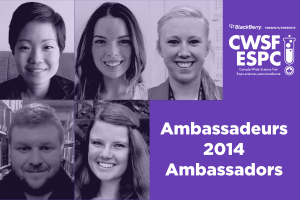
CWSF 2014 Ambassadors
Vivian Pang, Rachel Hunter, Jessie McAlpine, Todd Mercer, Dominique Drouin
CWSF 2013 Ambassadors
Erin Baker, Katherine Brown, Marc-Antoine Neron, Elise Tessier, Jennifer Payne, Nicholas Randall, Vivian Pang, Omar Chowdbury, Rachel Hunter
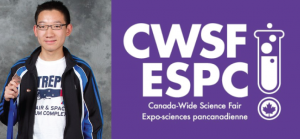
Kevin Dong
“Bringing together the brilliant young minds from across the Canada, CWSF truly is a place of education, innovation and friendship. It was one of the best experiences of my life. There is nothing like the feeling of using science and imagination to develop solutions and to share your work with like-minded individuals.”
Kevin Dong (CWSF 2014 – Gold Medalist, Environmental Challenge Award Winner, Actuarial Foundation of Canada Award Winner & 6 Scholarships)
Kevin Dong Profile: https://developinginnovations.org/?page_id=950
Interested in learning more about other amazing S.T.E.M. students and the latest S.T.E.M. news:
Like us at http://www.facebook.com/developinginnovations.org
Follow us at https://twitter.com/Aidan_Aird
CWSF Listing of 100 Regions for 2014
Alberta
- Calgary Youth – Calgary (City) and surrounding communities, including Strathmore.
- Canadian Rockies – The Alberta municipalities of Morley, Seebe, Exshaw, Lac des Arcs, Kananaskis, Dead Man’s Flats, Canmore, Harvie Heights, and Banff.
- Central Alberta – North to Ponoka; south to Carstairs; east to Stettler; west to Rocky Mountain House.
- Chinook Country – Nanton, Okotoks, Priddis
- Edmonton – Edmonton and surrounding communities.
- Lethbridge – Lethbridge and the southwest corner of Alberta, north to include Claresholm and Vulcan, and east to Vauxhall, Taber and Milk River.
- Peace Country – Whitecourt/Valleyview north and west to the Alberta/BC border.
- Southeast Alberta – Southeastern Alberta, including Medicine Hat.
- Wood Buffalo – Region of Wood Buffalo
British Columbia
- Cariboo Mainline – School Districts #27 – Cariboo-Chilcotin; #58 Nicola-Similkameen; #73 – Kamloops-Thompson; #74 – Gold Trail.
- Central Interior British Columbia – Quesnel School District (SD #28); Prince George School District (SD #57); Nechako Lakes School District (SD #91).
- Central Okanagan – Kelowna South to Osoyoos in South Central Okanagan – in geographical area covered by School Districts #23, 67 and 53.
- East Kootenay – Cranbrook, Fernie, Elkford, Sparwood, Kimberley, Invermere, Golden and the immediate areas around these locations.
- Fraser Valley – Lower Mainland – Langley, Chilliwack, Abbotsford, Hope, Mission and Maple Ridge – private, public and home schooled in grades K-12.
- Greater Vancouver – Lower Mainland, Sunshine Coast & Whistler/Squamish
- Northern British Columbia – School District 59, School District 60, School District 81, north to the Yukon/BC Border, east to the BC-Alberta Border.
- Northern Vancouver Island – Northern Vancouver Island
- Pacific Northwest – Haida Gwaii (SD#50); Prince Rupert (SD#52); Nisga’a (SD # 92); Terrace, Hazelton, Kitimat (SD#82); Smithers, Houston, Telkwa(SD#54).
- South Fraser – City of Surrey and Corporation of Delta, British Columbia
- Vancouver Island – Vancouver Island (south of, and including, Campbell River) and the Gulf Islands
- West Kootenay & Boundary – West Kootenay Region
Manitoba
- Manitoba First Nations – All First Nations operated schools in Manitoba.
- Manitoba Schools Science Symposium – Province of Manitoba – grades 4-12
- Northern Manitoba – Northern Manitoba, north of the 53rd Parallel.
- St. James-Assiniboia – St. James-Assiniboia School Division
- Western Manitoba – South Western Manitoba Please provide more details – cities/towns included or geographical boundaries.
- Winnipeg Schools – Winnipeg School Division
New Brunswick
- Districts francophones du Nouveau-Brunswick (DFNB) – Écoles francophones du Nouveau-Brunswick (6e à 12e année)
- Fundy
- River Valley
Newfoundland and Labrador
- Central Newfoundland – Burin Region (NLESD)
- Eastern Newfoundland – Avalon Peninsula.
Northwest Territories
- Beaufort-Delta – Beaufort-Delta Region (8 communities)
- Sahtu – Sahtu Region of NWT – consisting of communities – Norman Wells, Fort Good Hope, Tulita, Deline and Colville Lake.
Nova Scotia
- Annapolis Valley – Annapolis, Hants and Kings Counties.
- Cape Breton – Cape Breton – Victoria Regional School Board
- Chignecto East – Cumberland, Colchester and Pictou Counties
- Chignecto West – Western half of the Chignecto Central Regional School Board Area (with central offices in Truro, Nova Scotia).
- Conseil scolaire acadien provincial (CSAP) – Les élèves de la Nouvelle-Écosse inscrits dans les écoles du Conseil scolaire acadien provincial
- Halifax – Halifax Regional Municipality (with exception of CSAP schools, which hold their own SF)
- Mi’kma’q First Nation – Mi’kmaq First Nation Regional Science Fair for Nova Scotia
- South Shore – South Shore District School Board – Lunenburg and Queens Counties.
- Strait – Strait Regional School Board
- Tri-County – The counties of Shelburne, Yarmouth and Digby.
Nunavut
- Kitikmeot – Kitikmeot Region, Nunavut
- Kivalliq – Kivalliq Region, Nunavut.
Ontario
- Algoma Rotary – Algoma District, including Sault Ste. Marie
- Avon Maitland-Huron Perth – Huron and Perth Counties, Ontario.
- Bay Area – City of Hamilton, Regional Municipality of Halton, Counties of Brant, Haldimand, Norfolk.
- Bluewater – Grey and Bruce Counties, Ontario.
- Chatham-Kent – Municipality of Chatham-Kent.
- Durham – Ajax, Pickering, Whitby and Oshawa as well as the rural areas of Uxbridge, Brock and Scugog Townships.
- East Parry Sound – East Parry Sound – Callander to Novar
- Frontenac, Lennox & Addington – Frontenac, Lennox and Addington counties.
- Lambton County – Lambton County
- Niagara – Region of Niagara
- North Bay – Nipissing District and West Parry Sound District
- Northwestern Ontario – Thunder Bay, west to Atikokan and Pickle Lake, east to Manitouwadge and Greenstone, and north.
- Ottawa – Ottawa / Rockland
- PeelPeel Region
- Peterborough – Kawartha-Pine Ridge District School Board; 3/4 of Peterborough Catholic District School Board; 6 private schools.
- Quinte – Hastings and Prince Edward Counties
- Renfrew County – All students grade 6-12 in the County of Renfrew.
- Rideau-St. Lawrence – Lanark and Leeds-Grenville Counties
- Simcoe County – Simcoe County
- Sudbury – City of Greater Sudbury
- Sunset Country – Keewatin Patricia District School Board, Rainy River District School Board, Northwest Catholic District School Board, Kenora Catholic District Scho
- Thames Valley – Middlesex County, Elgin County, Oxford County and the City of London.
- Timmins – Northeastern Ontario from New Liskeard in the south to Moosonee in the north; Lake Superior in the west to the Québec border in the east.
- Toronto – City of Toronto
- United Counties – Stormont, Dundas & Glengarry Counties, Akwesasne – Mohawk Reserve
- Waterloo-Wellington – Waterloo Region, Wellington County, students of Upper Grand District School Board in Dufferin County
- Windsor – Windsor and Essex County
- York – York Region
Prince Edward Island
- Prince Edward Island – Residents of Prince Edward Island and those who attend public, private, home or band-operated schools in the province.
Québec
- Abitibi-Témiscamingue
- Aboriginal Québec Autochtone – Students from Quebec’s Aboriginal Schools / Élèves des écoles autochtones du Québec
- Côte-Nord
- Est du Québec
- Estrie
- Mauricie, Centre-du-Québec
- Montérégie
- Montreal
- Montréal CLS
- Outaouais
- Québec et Chaudière-Appalaches
- Rive-Nord
- Saguenay-Lac Saint-Jean
Saskatchewan
- Carlton Trail – Central Saskatchewan Bulyea (S) St Louis (N) Young(W) Kelvington (NE)
- Fransaskoise – Francophone students from the Division Scolaire Francophone No. 310 (Francophone School Division of Saskatchewan)
- Northern Saskatchewan – Northern Saskatchewan – All of Saskatchewan north of the Northwest Saskatchewan RSF, Prince Albert & Northeast Saskatchewan RSF and Prince Albert
- Northwest Saskatchewan – Northwest Saskatchewan (Please be more specific – clarify border with Northern Saskatchewan RSF and the southern border of your region.)
- Parkland – South/East Central Saskatchewan – From Foam Lake in the West to the Manitoba border; from Canora in the North to Rocanville in the South.
- Prairie Valley – In the new Prairie Valley School Division which is from Bethune to Moosomin (west to east) and approximately Lipton to Kennedy (north to south)
- Regina – City of Regina
- Saskatchewan Chinook – Southwest Saskatchewan – Region No. 2 (map submitted)
- Saskatchewan First Nations – Students from First Nations Schools in the province of Saskatchewan.
- Saskatoon – Saskatoon Public Schools, Greater Saskatoon Catholic Schools, Prairie Spirit School Division, and other students within Saskatoon
- Southeast Saskatchewan – 3 School Divisions in the southeast corner of Saskatchewan, including Estevan and Weyburn.
Yukon
- Yukon/Stikine – Yukon and Stikine region of British Columbia (i.e., Atlin, Dease Lake, Denetia and Tahltan Schools)
